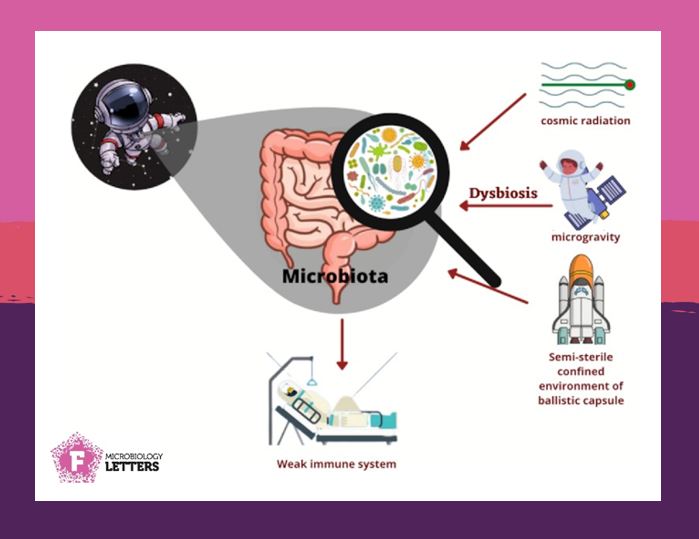Meet the Winners of the 2022 Best Article Award From FEMS Microbiology Letters
20-02-23
Smriti Arora, Samikshha Puri and Nitika Bhambri wrote the excellent MiniReview “A designer diet layout for astronauts using a microbiome mediated approach” for our journal FEMS Microbiology Letters. This was unanimously picked by the FEMS Microbiology Letters Editors-in-Chiefs as the best article for 2022!
We interviewed all the authors to find out more about the inspiration behind this paper:

Could you provide a brief, simple overview of the topic your paper covers?
The review highlights that being an astronaut not just requires one to be physically fit while joining but also to ensure fitness throughout the lifespan of this occupation. Space travellers experience several physiological stressors such as sleep disturbance, microgravity, constant noise, fluid shifts, disturbed circadian rhythm along with psychological stress. Consequently, a gut dysbiosis is observed in space travellers.
We proposed a diet fortified with pre-biotics, probiotics and synbiotics along with a contact time with plants (in space for long duration travellers) for emotional well-being of space travellers. The same are also recommended for post-flight recovery.”

What components does an ideal diet for astronauts include, taking in mind a healthy microbiome?
The diet of astronauts depends on space flight duration, the destination and the spacecraft limitations of keeping a sterile environment. It is also kept in mind that the space travellers experience menu fatigue. A healthy nutritious diet for space travellers (whether astronauts or space tourists) on ISS is composed of fresh fruits, vegetables and soups. Other items such as canned food, dehydrated food, medium moisture foods and, freeze dried food are also provided. Irradiated meat and breads are allowed too (Tang, H. et. al., 2021). The EuroMoonMars IMA HI-SEAS II (EMMIHS-II) mission recently limited fresh food in flight due to fear of introduction of new microbes. We in this review described how a low fibre, and processed diet scheme can lead to ‘gut dysbiosis.’ Insulin resistance has also been observed in both short term and long-term space missions revealing metabolic disturbance. The astronaut with highest diversity and species richness at the pre-flight levels had the most resilient gut microbiota post-flight. Further, research at Chinese Lunar Palace (LP1) revealed that a high plant, high fibre diet with a routine and contact time with plants was the best kind of diet for overall well-being. A sustainable Bioregenerative Life Support system (BLSS) recycling waste has been proposed to be used to grow plants and produce probiotics and synbiotics in space. Plants grown in space would be assumingly microbe free and also provide the requisite fibre in diet. Further, to avoid gut infections in space, freeze-dried phage cultures can be carried along as pre-cautionary measure. Overall, a plant-based diet has been observed to have received more positive outcome with our recommendations of inclusion of fibre, lactobacilli, bifidobacterial species and mucin degrader Akkermansia. An ideal diet would include prebiotic, probiotic, and synbiotic supplementation before, inflight and post flight.”
What encouraged you to perform research in this area of microbiology?
Space research and space agencies’ NASA/ESA’s research have always fascinated us. Furthermore, there were research articles that summarized astronaut nutrition, some summarized astronaut immunity and health but a state of art literature integrating diet, microbiome and immunity of astronauts appeared to be missing. Gut dysbiosis and its implications on human health have been understood in last few decades and now space agencies and scientists are integrating the research on diet with microbiome in space travellers. We decided to compile the state of art literature available to enable a personalized diet plan for astronauts based on microbiome data now available. Also, to ask some good research questions to improve health outcome and well-being of astronauts.”
What do you see as the next steps in this area of research?
A metabolome of astronauts pre-flight, in flight and post flight can be monitored to tailor a suitable diet plan based on the vitamins, SCFAs and presence or absence of other metabolites. For example, low levels of butyrate are a clue for dysbiosis and presence of trimethylamine-N-oxide (TMAO) is an indicative of increased risk of cardiovascular disease. The focus in space research according to us should be on tailoring diet with prebiotics, postbiotics and synbiotics on with a personalized layout to improve health of astronauts. Further, various kinds of BLSS are being researched on and attempted to be housed in spacecrafts to ensure sustainability of long-term missions without ill effects on astronauts’ health.”
Read the 2022 award winning paper: A designer diet layout for astronauts using a microbiome mediated approach
